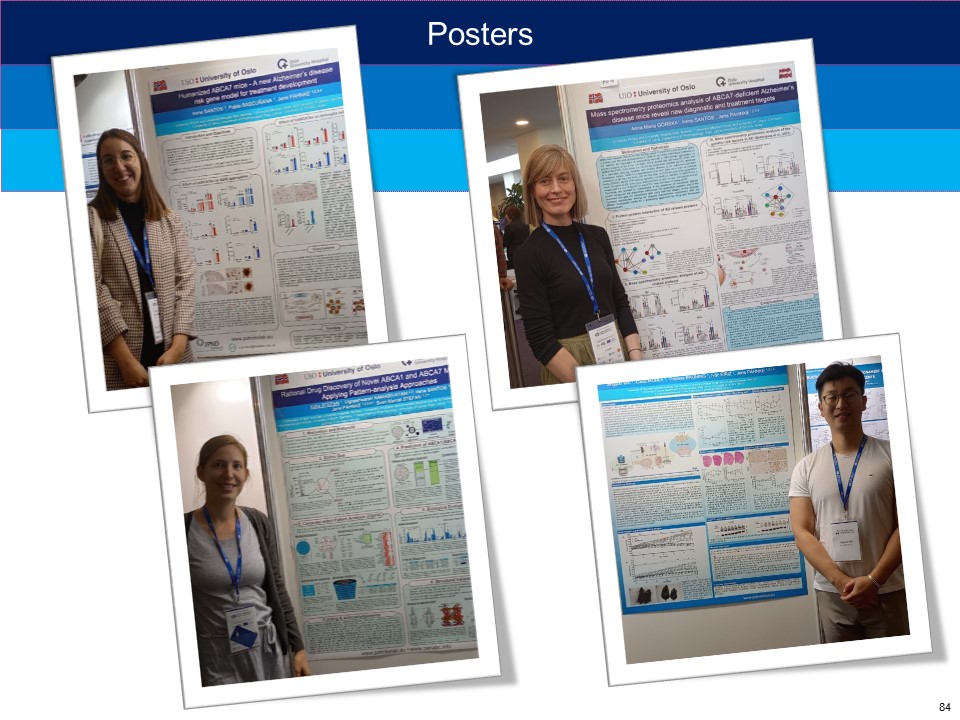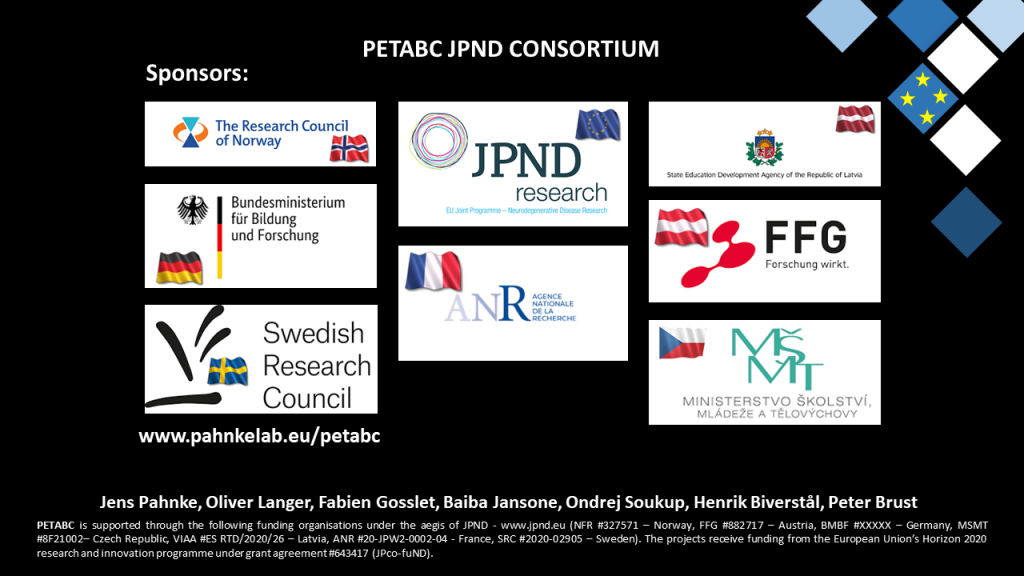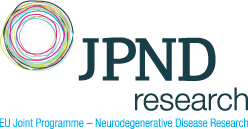<< back







PETABC: PET analyses of ABC transporter function for diagnostics and stratification of dementia patients
National funding: NFR (Norway), FFG (Austria), BMBF (Germany), ANF (France), VIAA (Latvia), MSMT (Czech Republic), SRC (Sweden)
EU funding: JPnd-coND
2021-2026
![]()

![]()
![]()
![]()
![]()
![]()
![]()
Coordinator:
Jens Pahnke, University of Oslo (UiO)/ Oslo University Hospital (OUS), Oslo, Norway
Partners:
Oliver Langer, Medical University Vienna, Vienna, Austria
Peter Brust, Universitätsklinikum Schleswig-Holstein (UKSH), Germany
Fabien Gosselet, Université d’Artois, Lens, France
Baiba Jansone, University of Latvia, Rīga, Latvia
Ondřej Soukup, Biomedical Research Center (BRC), Fakultní nemocnice Hradec Králové, Czech Republic
Henrik Biverstål, Karolinska Institutet, Stockholm, Sweden
Affiliated Consortium Members:
Aurélie Maisonial-Besset, IMoST – Imagerie Moléculaire et Stratégies Théranostiques – Université Clermont-Auvergne, France
Vigneshwaran Namasivayam, University of Lübeck / University Medical Center Lübeck, Germany
Abstract:
The blood-brain barrier (BBB) expresses different ATP-binding cassette (ABC) transporters, which control the access of endogenous and exogenous compounds from the blood into the brain as well as their removal from the brain into the blood. The export function of the BBB is of increasing importance and is moving continuously into the focus of research on neurodegenerative diseases (NDs). We have described for the first time that the ABC transporter C1 (ABCC1) is exceptionally important for the export of metabolites from the brain, especially for amyloid-β (Aβ)(1). In 2019, the first ABCC1 mutation was found in a family from Phoenix (AZ, USA) with inherited clinical Fronto-temporal Lobe Degeneration (FTD) and histological AD unpublished data. Apart from ABCC1, several other ABC transporters have been linked to NDs. Amongst them, a potential role of ABCA7 has been discovered in a large genome-wide association study (GWAS)(2). We hypothesized that ABC transporter function can be used to determine the impairment and remaining capacity of the BBB export in individual patients in vivo with different NDs (AD, PD, LBD, PSP)(3,4). Moreover, ABC transporters may be therapeutically targeted to enhance the Aβ export capacity of the BBB. To this end, we performed the drainAD phase IIa study (NCT03417986) to investigate the potential role of ABCC1 as a new diagnostic and treatment target for AD. The study showed that patients and controls excrete Aβ40 and Aβ42 in a time-dependent manner, presumably according to their BBB ABCC1 function. To further advance this novel therapeutic concept, methodology is critically needed to directly measure cerebral ABCC1 function in vivo in patients. Over the last years, partners of this consortium have performed multiple in vitro and functional animal studies in vivo to describe the function of ABCC1 and ABCA7, and have established a new positron emission tomography (PET) protocol to measure ABCC1 function in the rodent brain, which potentially can be used in patients (5,6).
Building on our previous work, we now aim to translate our new ABCC1 PET protocol to AD patients to assess whether cerebral ABCC1 function is impaired in comparison to age-matched healthy control subjects and to investigate the relevance of ABCC1 for the diagnostics of functional BBB-deficiency, which will allow better classification of patient groups. In parallel, we will extend our efforts toward ABCA7 and aim at developing the first PET radiotracers for imaging of ABCA7. These efforts will comprise several in vitro and in vivo investigations by using human and mouse cell culture BBB models (hPSC/iPSC-based and with specific knockout endothelia), humanized mouse models (hABCA7flx unpublished), chemical synthesis of new ABCA7 probes, morphological/toxicology analyses, ssNMR/cryo-EM, radiolabeling methods, and animal PET imaging. The humanized mouse models available to us are inducible and worldwide unique. These will enable us to assess the specific function of the human transport molecules A7 (and C1 (7), A1 under development) in different settings. Following a precision medicine approach, the segregation of disease diagnoses/sub-diagnoses based on ABC transporter function may potentially enable targeted treatment studies for those patients who show transport deficiency. Moreover, the assessment of ABC transporter function may potentially allow for the stratification of patient populations for preventive interventions.
1 Krohn, M. (2011) J Clin Invest 121, 3924-3931
2 Hollingworth, P. (2011) Nat Genet 43, 429-435
3 Bartels, A. L. (2009) Neurobiol Aging 30, 1818-1824
4 Bartels, A. L. (2008) J Neural Transm (Vienna) 115
5 Zoufal, V. (2020) J Cereb Blood Flow Metab 40, 954-965
6 Zoufal, V. (2019) Mol Imaging Biol 21, 306-316
7 Krohn, M. (2019) Mol Pharmacol 96, 138-147
Funding information:
PETABC is an EU Joint Programme – Neurodegenerative Disease Research (JPND) project. The project is supported through the following funding organisations under the aegis of JPND – www.jpnd.eu (NFR – Norway, FFG – Austria, BMBF – Germany, ANR – France, LZP – Latvia, MSMT – Czech Republic, SRC – Sweden). This project has received funding from the European Union’s Horizon 2020 research and innovation programme under grant agreement #643417 (JPco-fuND).
Resources / Links:
Pahnke lab
Langer lab – Clinical Pharmacokinetics /Pharmacogenetics and Imaging
Brust lab – Department of Neuroradiopharmaceuticals
Gosselet lab – Laboratoire de la Barrière Hémato-Encéphalique
Jansone lab – Department of Pharmacology
Soukup lab – Biomedial Research Center
Biverstål lab
Project progress:
Meeting at Drug Discovery Conference in Riga, 21-24. Sep 2022


Meeting at TransportDEMENTIA5 in Tromsø, 28. Aug – 1. Sep 2023

Posters at DDC2022 – Poster Prize to Katja Stefan (bottom left)

Opening Online meeting 24th April 2021


